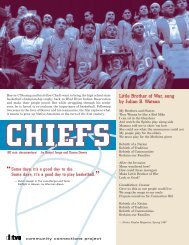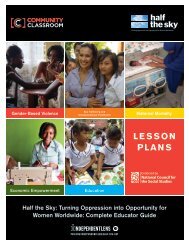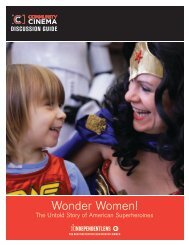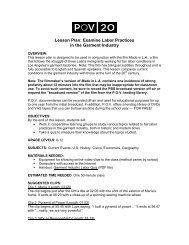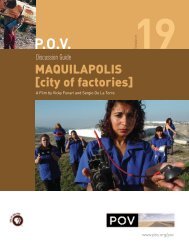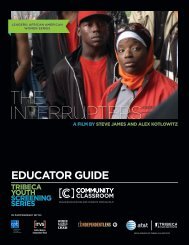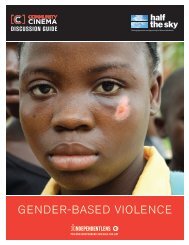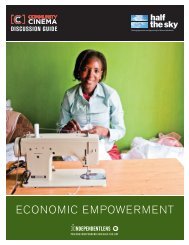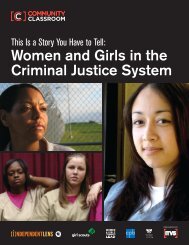CRIPS AND BLOODS Discussion Guide - PBS
CRIPS AND BLOODS Discussion Guide - PBS
CRIPS AND BLOODS Discussion Guide - PBS
- No tags were found...
Create successful ePaper yourself
Turn your PDF publications into a flip-book with our unique Google optimized e-Paper software.
discussion guideIt’s a civil war that’s lasted 40 years. Passed down from son to son. Fought eye for an eye. Over 15,000dead and counting, while the world stands by. Welcome to South Central Los Angeles. But what’s at theroot of this long-standing battle? Filmmaker Stacy Peralta hits the streets of LA to find out, and speakswith former and current members of the Bloods and the Crips, two of the most notorious and violentstreet gangs in America.www.pbs.org/independentlens/cripsandbloods
<strong>CRIPS</strong> & <strong>BLOODS</strong>: MADE IN AMERICAFrom the FilmmakerI made <strong>CRIPS</strong> <strong>AND</strong> <strong>BLOODS</strong>: Made In America because I wasinterested as a film-maker and as a resident of Los Angeles ininvestigating why gang violence has been going on uninterrupted inLos Angeles for over four decades. I could not understand why this isgoing on in America and why no viable solution has ever been put intoplace. And it did not make sense to me, our country defeated NaziGermany and Japan simultaneously and in less than a decade but wecan’t stop gang violence. It made me wonder if as a society we wouldfind a solution to this problem if instead of poor African-Americanteenagers it were affluent white teenagers who were killing eachother.Kumasi, who is one of the principle characters in the film says this,“part of the mechanics of oppressing people is to pervert them to theextent that they become their own oppressors.” I believe these youngmen involved in gang violence are carrying out their own extinctionand the very sad truth is that our society is allowing this to happen. Ihope people who view the film see these gang members as humanbeings caught up in a tragic nightmare and not as the animals anddemons the media has made them out to be.I believe people should see this film because this is a human rightsissue that is happening inside of America and it’s happening everydayin many of our largest cities – but it happens in silence. Theseyoung men are dying in silence and they are being incarcerated insilence. More people have been killed due to gang violence in LosAngeles than the long running sectarian conflict in Northern Ireland,yet very few know this fact. Young children in South Los Angeles areexperiencing greater levels of Post Traumatic Stress Disorder thanchildren living in Bagdad, Iraq. This is happening inside of our country.- Stacy Peralta, DirectorIndependent Television Service (ITVS) email: itvs@itvs.orgweb: www.pbs.org/independentlens/CommunityCinemapage 1
<strong>CRIPS</strong> & <strong>BLOODS</strong>: MADE IN AMERICAThe FilmWith a blend of on-camera interviews, historical footage, andscenes of current conditions, <strong>CRIPS</strong> & <strong>BLOODS</strong>: Made In Americagraphically portrays the ongoing street violence between rival AfricanAmerican gangs in South Los Angeles. In this 40-year feud, inwhich neighborhoods are staked out and rigid boundaries are drawn,crossing a street or taking a wrong turn can mean death. What isit that causes gang members to lock themselves into these tightlydefinedzones and so fiercely protect their turf? That question is at theheart of this film.Three former gang members—Ron, Bird and Kumasi—recount theirexperiences growing up in South Los Angeles in the 1950s, whensegregation ruled, both in organizations such as Boy Scouts andthrough neighborhood covenants that kept blacks and whites strictlyseparated. Young black males began forming their own groups—clubswhere they could find a sense of belonging. Fighting between rivalclubs became part of that culture, but the only weapons then were astrong pair of fists.Despite the discrimination experienced by African Americans, the1950s were a period of black prosperity and optimism in Los Angeles,fed by the abundance of industry-based jobs. By the late 1950s,however, those industries began to disappear, resulting in high ratesof unemployment and displacement of unskilled black workers. Theirdownward economic spiral combined with years of prejudice, racialprofiling and heavy-handed police methods to produce an explosivesituation. In 1965, a routine traffic stop erupted into full-scale civilconflict on the streets of Watts.In <strong>CRIPS</strong> & <strong>BLOODS</strong>: Made In America, current gang membersdescribe gang life and the status, protection and other benefits thatgang membership gives them. Their statements paint a bleak pictureof the physical, social and personal devastation that is the hallmarkof South Los Angeles. Even after a second eruption of riots in 1992,after the Rodney King police brutality trial, little has been doneto rebuild the area and to provide the education and employmentopportunities that could reduce violence and bring stability to thoseneighborhoods. With little help coming from the government, thevicious cycle of shootings and retaliation (which has produced anestimated 15,000 casualties in the past four decades) continues.Academics and other experts appear throughout the film, includingCalifornia state senator Tom Hayden and author Gerald Horne. Theyoffer perspectives on gang behavior and the disintegration of civilrule, and who suggest ways of solving the underlying problems, ratherthan just attacking gang-related street violence. The most promisingsolutions, however, may come from the people of South Los Angelesthemselves, where former gang members and other concernedindividuals have taken on the task of working with young people andproviding a positive alternative to gang membership. Examples of theirwork, and the new groups they have created, give the film an upbeatending.Some rays of hope appeared during the late 1960s, with the rise ofthe Black Pride movement. As groups such as the Black Panthersand the Student Nonviolent Coordinating Committee began providingservices and involving young people in community organizing, gangactivity hit an all-time low. The FBI, however, considered the Panthersa threat to the internal security of the country and began to target theleaders; many of them were killed or jailed. Without strong leadershipto steer black youth in positive directions, gangs became active oncemore, and this time their weapons were guns.Independent Television Service (ITVS) email: itvs@itvs.orgweb: www.pbs.org/independentlens/CommunityCinemapage 2
<strong>CRIPS</strong> & <strong>BLOODS</strong>: MADE IN AMERICAIndividuals featured in <strong>CRIPS</strong> & <strong>BLOODS</strong>:MADE IN AMERICABirdKumasiRonAll three of these men are former gang members who are currentlyactivists, educators and community leaders.Authors and academicsDr. Todd Boyd, University of Southern CaliforniaDr. Josh Sides, California State University, NorthridgeLeon Bing – Do or DieDr. Gerald Horne – Fire This TimeJames Gilligan, M.D. – ViolenceSenator Tom Hayden – Street WarsGang intervention leadersBo Taylor – former Crip, founder of Unity OneRock Johnson – former Crip, National Chief of Staff, Amer-I-CanVickey D. Lindsey – founder, Cry No MoreMinister Tony Muhammad – representative, Nation of Islam, founder ofPeace MakersT. Rodgers – founder, Sidewalk UniversityAquil Basheer – Maximum Force EnterpriseAqeela Sherrills – Reverence ProjectJim Brown – pro-football hall-of-fame member, founder of Amer-I-CanBACKGROUND INFORMATIONThe Attraction of GangsSociety’s contributionCertain factors create pre-conditions that can make gang membership anattractive and desirable option for young people. Societal factors include:• Racism: Denied access to opportunities and resources, young peoplemay form or seek to join an anti-establishment group.• Poverty: Being unable to partake in the economic life of a community,or even to obtain basic goods and services, can result in a sense ofhopelessness and a lack of self-worth. One way to earn cash is to joina gang involved in the drug trade or other illicit, but lucrative, activities.• Lack of a support network: When basic needs for love and protectionare not met because of family dysfunction, and if youth programsare not available in the community to provide additional support, youngpeople may turn to gangs to meet those needs.Who’s at risk?On a personal level, the list of risk factors includes:• Family poverty and dysfunction• Absence of a father figure• Low school achievement, possibly due to learning disabilities• Having friends who are delinquent• No positive activities or interests outside of school• Lack of positive role models• Behavioral problems at an early ageAdd to these personal factors the feelings of boredom that can comefrom living in an environment without acceptable outlets for young people,along with the peer pressure that is a fact of life among the young, andgang membership can become an irresistible attraction.Who joins and why?Gang characteristicsIn general, gangs tend to be urban, male and young. Within those parameters,there are numerous variations in gang membership, with The Cripsand Bloods representing one type of gang, the ‘turf’ gang. As its namesuggests, this type of gang is based on geography, albeit a limited one—the geography of perhaps a few dozen city blocks. Ethnic gangs aredefined by the nationality or race of the gang members, e.g., Latino orAsian; others, such as neo-Nazi gangs are defined by their opposition tocertain ethnic or religious groups. A third type of gang is the prison gang,which is made up of street gang members who continue their gang activityin prison. Gangs may also start in prison and keep going once membersare released.Estimates from the U.S. Department of Justice provide a rough profile ofgang composition:• In 2000, 94 percent of gang members were male and 6 percent werefemale.• 39 percent of gangs active in 2000 had at least one female member; 2percent of gangs were identified as being composed of predominantlyfemale members.• In 1996, 50 percent of gang members were under the age of 18, but in1999 only 37 percent of gang members were under the age of 18.•In 1999, 47 percent of gang members were Hispanic, 31 were AfricanAmerican, 13 percent were white, and 7 percent were Asian. These percentageshave remained fairly steady over the years.In addition, in 2001, 100 percent of cities with a population of 250,000or more reported gang activity, and 85 percent of cities with a populationbetween 100,000 and 229,999 reported gang activity.Source: U.S. Department of Justice, Office of Juvenile Justice and Delinquency Prevention, NationalYouth Gang Survey Trends from 1996 to 2000, by Arlen Egley, Jr.For young people experiencing the risk factors described previously, agang can provide:• acceptance, structure, and discipline• a sense of self-worth, status and respect• recognition and power• a sense of belonging, a ‘family’• companionship, training, excitement, and activities• physical safety and protection• the continuation of a family ‘tradition’, i.e., following in an older relative’sfootstepsIndependent Television Service (ITVS) email: itvs@itvs.org web: www.pbs.org/independentlens/CommunityCinema page 3
<strong>CRIPS</strong> & <strong>BLOODS</strong>: MADE IN AMERICAGang intervention strategies – Do they work?There have been few rigorous evaluations of gang intervention program,with most studies focused on community-based programs. A Bureau ofJustice Assistance report of results of gang-reduction strategies shows avery mixed picture:Prevention programs have shown some positive results. The Departmentof Justice’s school-based G.R.E.A.T. project has had modest effects onadolescents’ attitudes and delinquency risk factors. The Gang PreventionThrough Targeted Outreach (GPTTO) program, operated by the Boys andGirls Club, showed more positive outcomes for high risk than low riskyouths. Neither program, however, had an impact on gang membership.Intervention programs seem to work better when conducted intensivelyby a team of service agency professionals, rather than a one-on-oneapproach with gang members.Suppression programs using traditional law enforcement approachesresult in an increase in arrests and incarceration, but have no long-termeffects on gang membership and activity. Some programs that involvemultiple criminal justice agencies seem to be more effective.Comprehensive programs that include suppression, intervention andprevention activities within the community have shown substantial effectivenessin reducing gang violence. With a comprehensive approach, communitiesassess their own gang problems and create a complement ofprograms and anti-gang strategies. (See Resources for information on arelated publication.)Source: www.ojp.usdoj.gov/BJA/evaluation/program_law_enforcement/gangs2.htm “What Have WeLearned from Gang Programs/Strategies?”Independent Television Service (ITVS) email: itvs@itvs.org web: www.pbs.org/independentlens/CommunityCinema page 4
<strong>CRIPS</strong> & <strong>BLOODS</strong>: MADE IN AMERICATHINKING MORE DEEPLY1. What is the significance of the title, “<strong>CRIPS</strong> <strong>AND</strong> <strong>BLOODS</strong>: Madein America”? Is there something unique about the United Statesthat causes it to produce gangs and gang warfare?2. Why is the fighting between the Crips and the Bloods notrecognized as a civil conflict and treated as such by governmentauthorities?3. In 1965, when riots broke out in Watts, older and younger AfricanAmericans responded differently, based on their perspectives onrace relations. The former urged caution and nonviolence, while thelatter chose to fight in the streets. What accounted for the differentresponses by the older and younger generations?4. Commenting on the street violence in South Los Angeles, SenatorTom Hayden says, “It’s been defined as a crime problem and agang problem but it’s really an issue of no work and dysfunctionalschools.” Do you agree? Why or why not?5. What will it take to stop the gang warfare? Where shouldefforts begin?6. What responsibility does the government have in controlling or endingthe violence in South Los Angeles? What about the mothers,sisters, and other women whose male relatives have been involvedin the violence—what power do they have to make change happen?7. The film shows a quick series of yearbook-style photos of youngchildren, as well as other pictures of children on the streets ofSouth Los Angeles. What impact does seeing these photos haveon you?8. The film shows numerous shots of South Los Angeles today.What do those pictures tell about the current conditions there?9. What is your assessment of race relations today? What changes,if any, have taken place in your community over the last decadeor two? Is there evidence that shows a need for further change?Explain.10. Do you think the election of Barack Obama will be a catalyst forchange in places such as South Los Angeles? Why or why not?Independent Television Service (ITVS) email: itvs@itvs.orgweb: www.pbs.org/independentlens/CommunityCinemapage 5
<strong>CRIPS</strong> & <strong>BLOODS</strong>: MADE IN AMERICASUGGESTIONS FOR ACTIONTogether with other audience members, brainstorm actions that youmight take as an individual and that some people might do as a group.Here are some ideas to get you started:1. Find out how you can contribute to keeping young people outof gangs. Check with churches, social service agencies and lawenforcement organizations in your community to learn how you canparticipate in gang prevention activities.2. Organize a drive to support gang intervention organizations. Thesegroups are often underfunded and fragmented. (See Resources)3. Organize or join a community activist coalition to lobby for theclean-up and development of a run-down or blighted area of yourcommunity. Include young people in this effort. Encourage themto brainstorm and outline their ideas, and offer them training andsupport in presenting their plans to local officials.4. Volunteer for a day (or a series of days) of community service withHabitat for Humanity or with another initiative that works toconstruct or repair local schools and community buildings.5. Help keep the streets of your community safe by taking part incommunity policing. Schedule a forum or town hall meeting withlocal police, churches, businesses and other organizations toinform the community about how community policing works.Basic, easy-to-understand information can be found atwww.besafe.org/css_com/community_policing/index.html.6. Mentoring a young person can help him or her develop skills andinterests that lead to positive life outcomes. Look into mentoringopportunities through Big Brothers Big Sisters or other organizations(see Resources).7. Get involved in efforts to stop racial profiling. Both the ACLU(www.aclu.org/racialjustice/racialprofiling/index.html) and AmnestyInternational (www.amnestyusa/us-human-rights/racial-profiling/page.do?id=1106650) have projects focused on ending racialprofiling. Check their web sites to learn what actions you can take.For additional outreach ideas, visit www.itvs.org, the web site for theIndependent Television Service. For local information, check theweb site of your <strong>PBS</strong> station.RESOURCESGang information & historyhttp://people.howstuffworks.com/street-gang.htm – This site offers ageneral overview of street gangs and their history.www.knowgangs.com/gang_resources/menu.php – Founded by a lawenforcement officer, this site provides gang profiles, resources andother details about gangs.www.lapdonline.org/get_informed/content_basic_view/1396 – Theofficial L.A. Police Department website offers general comprehensiveinformation about gangs.www.streetgangs.com/history/hist01.html – This site features an articlecalled “Black Street Gangs in Los Angeles: A History.”www.gangresearch.net/GangResearch/Policy/cripsbloodsplan.html –Check out a comprehensive plan for the reconstruction of South LosAngeles, drawn up in 1992 by the Bloods and the Crips, as a reactionto the aftermath of the Rodney King trial.www.urbanministry.org/wiki/gang-statistics – This section of the UrbanMinistry website provides gang statistics at a glance.Gang intervention & preventionwww.helpinggangyouth.com/statistics.html – This website offers awide range of information, including steps to prevent gang involvement,gang statistics and advice for parents of at-risk youth.www.focusas.com/Gangs.html – Focus Adolescent Services’ comprehensivewebsite for families with troubled and at-risk teens containsa section on gang issues, including a list of related organizations andinformation resources.www.bgca.org/programs/specialized.asp – This Targeted Outreachprogram from the Boys & Girls Clubs works with youth aged 6-18.www.great-online.org – Gang Resistance Education and Training—G.R.E.A.T.—is a school-based program from the US Department ofJusticewww.usmayors.org/bestpractices/community_policing_2006/gangBP_2006.pdf – “Best Practices of Community Policing in GangPrevention and Gang Violence” is a 144-page report by the U.S.Conference of Mayors, with short chapters describing initiatives in 55communities, large and small, across the countrywww.be-safe.org/css_com/community_policing/index.html – This siteprovides a clear, illustrated description of what community policing isand how it works.www.amer-i-can.org – Founded by former Cleveland Browns fullbackJim Brown, the Amer-I-Can Program is a life management skills curriculumthat is designed to empower individuals to take charge of theirlives and achieve their full potential.www.iir.com/nygc/publications/gang-problems.pdf – “Best Practices toAddress Community Gang Problems: OJJDP’s Comprehensive GangModel” describes a comprehensive community approach to anti-gangstrategies.Independent Television Service (ITVS) email: itvs@itvs.orgweb: www.pbs.org/independentlens/CommunityCinemapage 6
<strong>CRIPS</strong> & <strong>BLOODS</strong>: MADE IN AMERICAMentoring & community actionwww.cripsandbloodsmovie.com – The website for the film lists all theorganizations featured or mentioned at the end of <strong>CRIPS</strong> & <strong>BLOODS</strong>:MADE IN AMERICA. While most of them are focused on Los Angelesor other California communities, some are national in scope.www.solutionsforamerica.org/index.html – A companion project ofthe Pew partnership for Civic Change, Solutions for America providesguidance for civic problem solving, including information on mentoring.www.nwrel.org/mentoring – The Northwest Regional EducationLaboratory’s National Mentoring Center offers training, resources andonline services to local mentoring programs.www.mentoring.org – MENTOR/National Mentoring Partnership isan advocate and resource for the expansion of mentoring initiativesnationwide. It maintains a network of state mentoring partnerships anda rich variety of resources to support mentors.<strong>CRIPS</strong> & <strong>BLOODS</strong>: Made in America WILL AIR NATIONALLY ON THE EMMYAWARD-WINNING <strong>PBS</strong> SERIES INDEPENDENT LENS IN MAY, 2009.CHECK LOCAL LISTINGS.<strong>CRIPS</strong> & <strong>BLOODS</strong>: Made in America was directed by Stacy Peralta and producedby Baron Davis, Cash Warren, Shaun Murphy and Gus Roxburgh.The Emmy Awardwinningseries Independent Lens is jointly curated by ITVS and <strong>PBS</strong> and is fundedby the Corporation for Public Broadcasting (CPB) with additional funding providedby <strong>PBS</strong> and the National Endowment for the Arts.ITVS COMMUNITY is the national community engagement program of theIndependent Television Service. ITVS COMMUNITY works to leverage the uniqueand timely content of the Emmy Award-winning <strong>PBS</strong> series Independent Lens tobuild stronger connections among leading organizations, local communities andpublic television stations around key social issues and create more opportunitiesfor civic engagement and positive social change. To find out more about ITVSCOMMUNITY, visit www.pbs.org/independentlens/communitycinema.www.bbbs.org – Big Brothers Big Sisters offers a wide array of mentoringopportunities, including African American, Hispanic and NativeAmerican mentoring.www.amer-i-can.org/ – Amer-I-Can is comprised of the Amer-I-CanProgram, which is a 60-to-90 hour, 15 chapter Life ManagementSkills curriculum designed to empower individuals to take charge oftheir lives.www.unityonenow.com – Unity One is about building a better futureand stronger community through education, empowerment, improvingindividual motivation and creating lasting opportunities for all people.www.maximumforceenterprises.com – Maximum Force Enterprisesseeks to provide a wide-ranging array of services that deal directlywith all aspects of violence abatement and threat eradication.www.volunteermatch.org/search/org92771.jsp – Project Cry NoMore's mission is to stop the gang/gun violence that continues toplague communities across the country, as well as the world. ProjectCry No More is a self-supported, nonprofit through featuring ongoingemotional support, education, prevention, intervention, advocacy andawareness.www.icanallstars.com – I-Can Youth Foundation is a local nonprofitorganization dedicated to serving youth through sports, mentoring,tutoring and life skills. They are made up of community volunteersincluding parents, members of law enforcement, aerospace, clergy,firemen, military personnel, entertainers and athletes.http://2ndcall.org – 2nd Call is a community-based organizationdesigned to assist in the personal development of needy individuals:at-risk youth, ex-felons, parolees and others who society disregards.Independent Television Service (ITVS) email: itvs@itvs.org web: www.pbs.org/independentlens/CommunityCinema page 7




